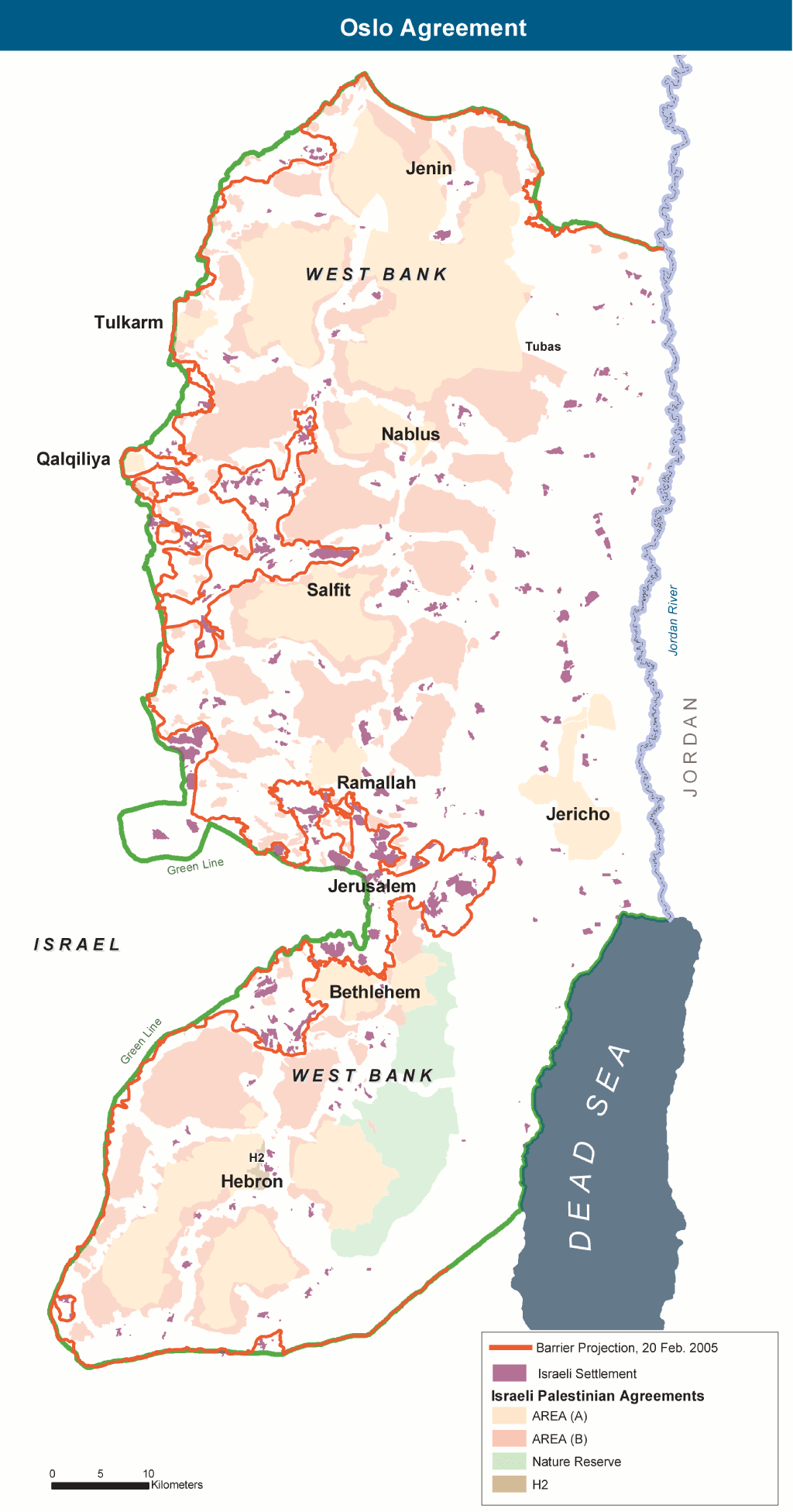Do you know your Area A from your Area C? Judging by the media coverage, you’d think that the Palestinians in the disputed territories are under the complete control of Israel. The status of Judea and Samaria, or the West Bank, is actually more complicated. Administrative arrangements resulting from the Oslo Accords divided the territory into Areas A, B and C, which still, even after so many years, have a significant impact on the lives of Palestinians and Israelis living there.
Under the terms of the Oslo agreements, the Palestinians were to be given a degree of self-government under the Palestinian Authority during what was supposed to be a process leading to a permanent agreement on all of the core issues. Despite numerous attempts, a permanent agreement is no closer.
The Gaza Strip (since completely evacuated by Israel) and the West Bank were divided into three zones according to the Oslo II Accord:
- Area A – which would be under the Palestinian Authority’s full control and include all Palestinian cities and surrounding areas with no civilian Israeli presence.
- Area B – which would be under the Palestinian Authority’s civil control and Israel’s security control and include areas of dense Palestinian population with no civilian Israeli presence.
- Area C – which would be under full Israeli control, except over Palestinian civilians. This area includes all West Bank settlements and their immediate vicinity as well as strategic areas dubbed “security zones.”
The idea behind the division of the West Bank was based not on territorial size but on enabling the greatest number of Palestinians to be under full Palestinian control while maintaining the security of Jewish settlements and Israel’s borders.
What does this mean in practice?
Hillel Frisch explains:
The differences between areas A, B and C, all pertaining to Judea and Samaria, are relatively simple.
Area A is the space in which the PA has political and military jurisdiction over its residents – all of whom are Arab.
This includes all of the major towns and their immediate environs – with the partial exception of Jewish Hebron, which came under exclusive Israeli control in the 1997 Hebron protocol between Israel and the PLO. This area comprises approximately 18 percent of Judea and Samaria’s land mass.
According to the Oslo Accords, the PA was never given jurisdiction over Israeli citizens and foreign nationals.
Israeli citizens have the right to enter and pass through Area A unmolested, provided that they are not involved in illicit activity, in which case the PA can only temporarily apprehend them until they are transferred to the Israeli authorities. Joint Israeli-PA patrols were intended to handle these cases.
THE NEXT letter in the alphabet signified less built-up areas, many of which shared their space with settlements created in the massive settlement drive in the 1980s launched by the Likud government. Area B comprises approximately 22% of Judea and Samaria.
In Area B, Israel and the PA share jurisdiction.
Israel enjoys exclusive jurisdiction over the Jewish inhabitants and exclusive authority over security for both its Arab and Jewish inhabitants. The PA has political, administrative and police jurisdiction over the Arab inhabitants. They are subject to its laws, pay the necessary taxes and benefit from the same public services the PA provides in Area A.
Strictly speaking, only the IDF and the Israel Police can make arrests in these areas.
MOST OF geographic Judea and Samaria (60% of the area) is designated Area C, over which Israel has exclusive jurisdiction both administratively and in security matters.
Area C’s distinguishing characteristic is that it is sparsely populated – by Arab or Jewish inhabitants.
Most of this area lies east of the populated mountain spine from Jenin in the north to Hebron in the south. The eastern slopes descending and including the Jordan Valley are characterized by harsh climate and low to no rainfall. The Jordan Valley, the South Hebron Hills and the area in the vicinity of Ma’aleh Adumim – from east of Mount Scopus to Jericho – are by far the most politically contested spaces in Area C, due to both Jewish settlement and Israeli security concerns.

While the arrangement was a product of Oslo, it raises numerous contemporary issues including:
- Discussions over annexation of all or parts of the West Bank by some on the Israeli right-wing: In the event of this actually happening, it would most likely be Area C that would be annexed.
- Settlement building in Area C: According to the Oslo Accords, Israel is legally allowed to build there i.e. the Palestinian negotiators agreed to it. Despite this, Israel is often accused of settlement expansion against the wishes of both the Palestinians and many in the wider international community.
- Palestinian building: Conversely, Israel is responsible for granting Palestinians building permits in Area C.
- The influence of the European Union and other foreign governments: Palestinian communities in Area C have benefited from foreign aid and development, much to the chagrin of Israeli governments that consider this to be political meddling. European aid for Palestinian construction in Area C is regarded as illegal by Israel.
David Weinberg argues:
It is often alleged that Israeli settlement in Judea and Samaria is “gobbling-up” Palestinian lands in Area C. This is nonsense, as a straightforward encounter with basic facts makes clear that most of Area C is breathtakingly empty: the Judean desert, the northern Samarian desert and the Jordan Valley. These precincts are mostly nature reserves, firing zones and grazing grounds, amounting to more than half of the land in Area C (200,000 of the 350,000 hectares, or 500,000 of 860,000 acres).
All Jewish and Arab inhabitation of Area C cover only about 40% of the land mass. That consists of about 200,000 Palestinians in 25 towns and hundreds of unorganized hamlets, with homes sitting on 8% of the territory and agriculture on another 25%. There are also 400,000 Israelis living in Area C, and their settlements sit on only 2.5% of Area C (which means that their population density is currently more than six times as much), with plans for expansion to another 7%.
The division of Judea and Samaria / the West Bank into Area A, B and C may well be a throwback to a different era, the Oslo peace years where this arrangement was thought to be a temporary one. It has nonetheless effectively become the status quo.
But can this status quo last indefinitely?


